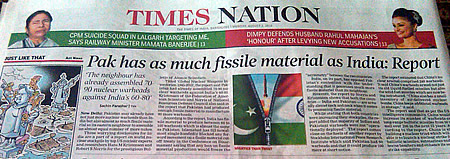 |
| India-Pakistan nuclear competition on display again |
.
By Hans M. Kristensen
If Indian news reports (here, here, and here) are any indication, India has once again discovered that Pakistan might possess a few nuclear weapons more than India.
This time the reports are based on an article Robert Norris and I published in the Bulletin of the Atomic Scientists, in which we provide estimates for the number of nuclear weapons in the world.
In 2009, our report on Pakistan’s nuclear forces triggered a statement from the chief of the Indian army that if the warhead estimate in our report was correct then Pakistan had moved beyond what is needed for deterrence. The unintended acknowledgement: so had India.
In 2008, reports about the arrival of the first Chinese Jin-class SSBN at a naval base on Hainan Island were followed by suggestions that India needed to build perhaps five new Arihant-class ballistic missile submarines.
As far as I can gauge, apart from nuclear testing where India started first, Pakistan has always been a little ahead in warheads, fissile material, and delivery systems. But neither country can claim any nuclear moral high ground; both are increasing their nuclear arsenals, both are producing more fissile material for nuclear weapons, and both are diversifying the means to deliver nuclear weapons and extending their range.
The two countries are now at a warhead level about equal to that of Israel (~80 warheads). But whereas it took Israel 40 years to reach that level, India and Pakistan have done so in only 12 years. And they’re apparently not done.
Although neither government wants to say so publicly, India and Pakistan are in effect in a nuclear arms race. It might not be of the intensity of the Cold War arms race between the Soviet Union and the United States, but it is a race nonetheless for capability and systems. Pointing to the other side having more only underscores that dynamic.
Indian and Pakistani security will probably be served better by trying soon to define just how big a nuclear force is sufficient for minimum deterrence so that “prudent planning” doesn’t take them to a new and more dangerous level.
This publication was made possible by a grant from Carnegie Corporation of New York and Ploughshares Fund. The statements made and views expressed are solely the responsibility of the author.
The FY2026 National Defense Authorization Act (NDAA) paints a picture of a Congress that is working to both protect and accelerate nuclear modernization programs while simultaneously lacking trust in the Pentagon and the Department of Energy to execute them.
While advanced Chinese language proficiency and cultural familiarity remain irreplaceable skills, they are neither necessary nor sufficient for successful open-source analysis on China’s nuclear forces.
Satellite imagery has long served as a tool for observing on-the-ground activity worldwide, and offers especially valuable insights into the operation, development, and physical features related to nuclear technology.
This report outlines a framework relying on “Cooperative Technical Means” for effective arms control verification based on remote sensing, avoiding on-site inspections but maintaining a level of transparency that allows for immediate detection of changes in nuclear posture or a significant build-up above agreed limits.